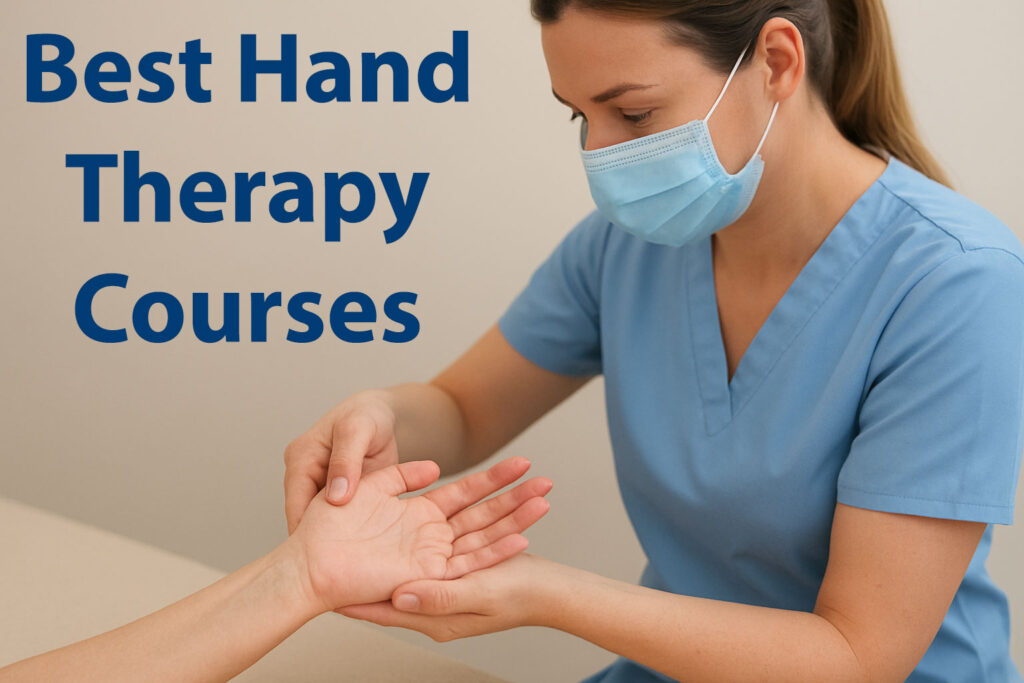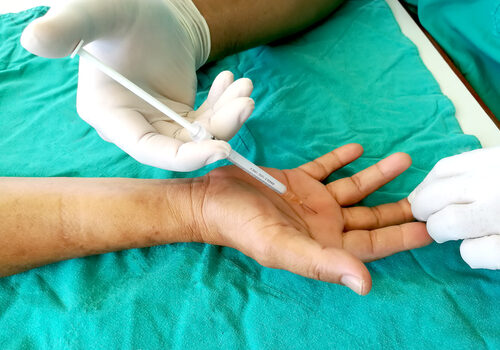Hand therapy is a rapidly growing specialization within the fields of occupational and physical therapy. With the increasing demand for professionals trained in treating upper extremity conditions, pursuing 手部治疗课程 can be a game-changer for your career. Whether you’re a new graduate or a seasoned therapist looking to expand your skill set, the right course can offer the knowledge, certification, and confidence you need to succeed.

Introduction to Hand Therapy
What is Hand Therapy?
Hand therapy is a specialized area of rehabilitation focused on the treatment of injuries and conditions affecting the hands, wrists, forearms, and shoulders. It combines knowledge from both occupational therapy (OT) and physical therapy (PT) to restore function, reduce pain, and improve mobility.
Importance of Specialized Hand Therapy Training
Unlike general therapy courses, hand therapy requires in-depth anatomical knowledge, specific rehabilitation techniques, and skills in orthotic fabrication. Specialized training ensures therapists are equipped to handle complex cases like tendon repairs, fractures, arthritis, and neurological impairments.
Who Should Take Hand Therapy Courses?
Occupational Therapists
OTs often seek hand therapy courses to qualify for the Certified Hand Therapist (CHT) credential, enhancing their clinical skills and credibility.
Physical Therapists
PTs benefit from understanding the intricacies of the upper extremity, allowing them to offer more comprehensive care and broaden their practice scope.
Students and New Graduates
Even early-career professionals can begin their journey with foundational courses that prepare them for advanced certifications later on.
Key Learning Objectives of Hand Therapy Courses
Anatomy and Biomechanics of the Hand
Courses dive deep into the musculoskeletal and nervous systems of the upper limb, teaching how injuries and diseases affect motion and strength.
Rehabilitation Techniques
Participants learn evidence-based methods for therapeutic exercise, manual therapy, and modalities tailored to hand injuries.
Post-Surgical Interventions
Special attention is given to treating patients after surgeries like tendon repairs or joint replacements, with protocols for safe and effective recovery.
Online vs. In-Person Hand Therapy Courses
Pros and Cons of Online Learning
优点: Flexible schedules, accessibility from anywhere, and often lower costs.
缺点: Lack of hands-on experience, limited networking.
Benefits of Hands-On Training
In-person training offers real-time feedback, clinical simulations, and practical applications that are essential for mastering splinting and manual therapy techniques.
Top Accredited Hand Therapy Certification Programs
Certified Hand Therapist (CHT) Prep Course
The gold standard in hand therapy credentials, requiring 4,000 hours of clinical practice and passing a rigorous exam.
Hand Therapy Academy Courses
Renowned for online CEUs, HTA provides engaging video lectures and interactive learning tools.
Short-Term vs. Long-Term Courses
Weekend Workshops
Great for specific topics like splint fabrication or ergonomic assessments. Ideal for those looking to upskill quickly.
Intensive Certifications
Extended programs offer a deeper dive, culminating in advanced practice competencies and sometimes certification prep.
Best Hand Therapy Courses
Wound care in Hand Therapy
This course covers everything you need to know about treating wounds in the hand therapy setting.
Splinting Made Easy
This orthosis/splint fabrication course covers 23 different splints! It includes an ebook with a how-to guide for each splint to utilize as a quick resource in the clinic.
防弹文档
Documentation is key to everything we do in therapy. This course will make sure your notes comply with all standards.
What to Look for in a Quality Course
- Course Accreditation: Ensure the course is recognized by professional boards.
- Instructor Credentials: Look for instructors with clinical and academic expertise.
- Practical Assignments and Case Studies: Real-world applications improve learning and retention.
Costs and Budgeting for Courses
Average Price Range
Prices vary widely—online courses can start at $50, while full certification programs may cost upwards of $1,000.
Scholarships and Employer Sponsorships
Check with employers or professional associations for potential funding opportunities or reimbursement programs.
Course Duration and Time Commitment
Self-Paced vs. Scheduled Programs
Self-paced courses offer flexibility but require discipline. Scheduled programs provide structure and accountability, often with deadlines and peer interactions.
Real-Life Case Studies and Applications
Post-Surgical Rehabilitation
Courses use examples like flexor tendon repair to demonstrate rehab timelines and splinting protocols.
Chronic Hand Conditions
Learn to manage conditions like rheumatoid arthritis, carpal tunnel syndrome, and CRPS with therapeutic interventions.
Advanced Topics in Hand Therapy Courses
Neurological Disorders
Explore treatments for strokes, nerve injuries, and neuromuscular disorders affecting hand function.
Custom Splint Fabrication
Hands-on training in creating static, dynamic, and static-progressive orthoses tailored to patient needs.
Continuing Education Units (CEUs) and Licensing
CEUs Required for CHT
Therapists must earn ongoing CEUs to maintain their certification and licensing status.
Reporting and Renewal Processes
Ensure your courses provide certificates for CEUs and meet state board or national exam board requirements.
Testimonials and Reviews from Course Participants
Success Stories
Therapists often report increased confidence, better job opportunities, and improved patient outcomes.
Common Feedback Trends
Participants value hands-on demos, expert lectures, and practical applications over purely theoretical content.
Career Opportunities After Completion
Clinics and Hospitals
Graduates often land roles in orthopedic clinics, surgical rehab units, and hand therapy departments.
私人诊所
Specialized knowledge allows for the establishment of niche private practices catering to upper extremity rehab.
Teaching and Research
Advanced learners may transition into academia or clinical research, contributing to the body of knowledge in hand therapy.
常见问题 (FAQ)
1. How do I become a hand therapist?
To become a Certified Hand Therapist (CHT), you need to be a licensed OT or PT, complete 4,000 hours of direct hand therapy experience, and pass the CHT exam.
2. Are online hand therapy courses recognized?
Yes, many online courses from accredited providers like Hand Therapy Academy are accepted for CEUs and CHT prep.
3. What is the CHT exam?
The Certified Hand Therapist exam is a comprehensive test administered by the Hand Therapy Certification Commission (HTCC) that assesses advanced clinical knowledge and application.
4. Can I take these courses internationally?
Absolutely! Many providers offer global access to online courses. However, check if they meet your country’s licensing or certification requirements.
5. Do these courses count toward CEUs?
Most professional courses are accredited and count toward your required Continuing Education Units (CEUs) for license renewal or certification.
6. How long does it take to become certified?
It generally takes a few years post-licensure to accumulate the 4,000 clinical hours required for the CHT exam, plus additional time for course preparation and study.
Conclusion: Choosing the Right Hand Therapy Course for You
Choosing the right hand therapy course boils down to your career goals, time availability, and learning style. Whether you aim to achieve CHT certification or simply want to improve your manual therapy skills, there’s a course out there that fits your path. Evaluate options based on content, credibility, cost, and flexibility—and get ready to transform your practice and patient outcomes.
更多阅读内容
可的松注射液的优点和缺点
作者:Shruti Jani 患者经常会询问治疗师对可的松注射的看法。可的松注射非常有帮助,可以显着减轻炎症,但是,一些治疗师认为这可能掩盖疼痛,而不是解决问题的真正根源。这经常在治疗师之间争论。优点的简短摘要...
阅读更多职业治疗继续教育的优秀专家建议
了解职业治疗继续教育 什么是职业治疗继续教育?职业治疗继续教育是指结构化的学习活动,旨在帮助职业治疗师 (OT) 保持专业能力、拓展技能并紧跟医疗保健领域的发展。这些课程通常以继续教育学分 (CEU) 或专业发展学分来衡量……
阅读更多训练任务对上肢假肢模拟中手间转移的影响
作者:Emilee Saunders、Romkema, S.、Bongers, RM、van der Sluis, CK (2017)。训练任务类型对上肢假肢训练中手间传递效应的影响:一项随机事前-事后测试研究。PLoS ONE 12(11): e0188362。概要:本研究旨在探究训练“未受影响”的手臂是否会使“受影响”的手臂受益……
阅读更多注册即可直接将更新发送到您的收件箱!
注册我们,我们将定期向您发送有关手部治疗的所有内容的博客文章、每次上传新视频和教程时的通知,以及讲义、协议和其他有用信息。




